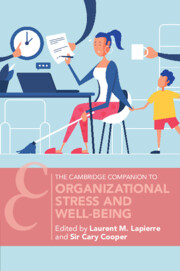Book contents
- Organizational Stress and Well-Being
- Cambridge Companions To Management
- Organizational Stress and Well-Being
- Copyright page
- Contents
- Figures
- Tables
- Contributors
- Introduction
- Part I Historical Evolution and Continued Relevance of the Study of Organizational Stress and Well-Being
- 1 From Occupational Fatigue to Occupational Health
- 2 Impacts of Stress and Well-Being on Organizations and Societies
- 3 Theories of Organizational Stress and Well-Being
- Part II Line Managers
- Part III Major Issues Relating to Stress and Well-Being
- Part IV Workplace Interventions Addressing Stress and Well-Being
- Part V Emerging Issues
- Subject Index
- References
2 - Impacts of Stress and Well-Being on Organizations and Societies
A Global Perspective
from Part I - Historical Evolution and Continued Relevance of the Study of Organizational Stress and Well-Being
Published online by Cambridge University Press: 23 February 2023
- Organizational Stress and Well-Being
- Cambridge Companions To Management
- Organizational Stress and Well-Being
- Copyright page
- Contents
- Figures
- Tables
- Contributors
- Introduction
- Part I Historical Evolution and Continued Relevance of the Study of Organizational Stress and Well-Being
- 1 From Occupational Fatigue to Occupational Health
- 2 Impacts of Stress and Well-Being on Organizations and Societies
- 3 Theories of Organizational Stress and Well-Being
- Part II Line Managers
- Part III Major Issues Relating to Stress and Well-Being
- Part IV Workplace Interventions Addressing Stress and Well-Being
- Part V Emerging Issues
- Subject Index
- References
Summary
Worldwide adverse impacts of occupational stressors are timeless concerns to humanity. These impacts not only disrupt mental and health well-being of workers and their families but also impede growth and prosperity of organizations, societies, and nations. In this chapter, we first reviewed to what extent occupational stressors have created burdens on organizations and nations in terms of economic costs (e.g., productivity loss and health care cost) and health outcomes (e.g., morbidity and mortality). After that, we reviewed work-related legislations enacted to address five occupational stressors (i.e., age discrimination, racial discrimination, sex discrimination, sexual harassment, and workplace bullying). To conduct the review, we surveyed these legislations across each continent/ geopolitical region, including Australia, Canada, China, France, Germany, Russia, Singapore, Slovakia, South Africa, South Korea, the UK, and the US. Finally, we summarized the progress of occupational stress research and offered ways of advancing preventive organizational stress management.
Keywords
- Type
- Chapter
- Information
- Organizational Stress and Well-Being , pp. 30 - 64Publisher: Cambridge University PressPrint publication year: 2023

